


The National Transportation Safety Board (NTSB) has released the Preliminary report of a fatal mid-air crash at the Dallas Executive Airport (RBD) , were a total of eight vintage aircraft were involved in the display being executed , a flight of three fighters and a flight of five bombers.
On November 12, 2022, about 1322 central standard time, a Boeing B-17G airplane, N7227C and a Bell P-63F airplane, N6763, collided in midair at the Dallas Executive Airport (RBD), Dallas, Texas. A post impact fire ensued. The pilot, co-pilot, and three crewmembers onboard the B-17G and the pilot of the P-63F were all fatally injured.
There were no ground injuries reported. Both airplanes were operated under the provisions of Title 14 Code of Federal Regulations Part 91 in the Wings Over Dallas Airshow. The P-63F was number 3 of a three-ship formation of historic fighter airplanes and the B-17G was lead of a five-ship formation of historic bomber airplanes.
NTSB investigators made use of the recovered audio and ADS-B data to reconstruct the definition - how the aircraft were arrayed !
According to the recorded audio for the airshow radio transmissions and Automatic Dependent Surveillance-Broadcast (ADS-B) data, the air boss directed both formations to maneuver southwest of the runway before returning to the flying display area, which was the designated performance area.
He directed the fighter formation to transition to a trail formation, fly in front of the bomber formation, and proceed near the 500 ft show line. The bombers were directed to fly down the 1,000 ft show line. The 500 ft show line and 1,000 ft show line were 500 ft and 1,000 ft respectively from the airshow viewing line behind which the audience viewed the airshow.
Investigators highlighted the absence of the altitude deconfliction briefing before the formation display, which could be among the major factor leading to the crash ,
There were no altitude deconflictions briefed before the flight or while the airplanes were in the air. When the fighter formation approached the flying display area, the P-63F was in a left bank and it collided with the left side of the B-17G, just aft of the wing section.
Both airplanes broke up in flight and impacted terrain in a grassy area on airport property south of the approach end of runway 31. A fire ignited in the wing center section of the B-17G as it descended to the ground. The B-17G exploded upon ground impact.
The debris field was generally aligned on a magnetic heading of 320°. Documentation of the accident site found all major flight control components for both airplanes located in the debris field.
Both airplanes were equipped with ADS-B. An Avidyne IFD540 unit from the B-17G and a Garmin GPSMAP 496 unit from the P-63F were recovered and submitted to the National Transportation Safety Board Vehicle Recorders Laboratory. The IFD-540 contained position information relevant to the accident; however, the GPSMAP 496 did not record any information for the accident flight. The wreckage of both airplanes was retained for further examination.
Source : NTSB
